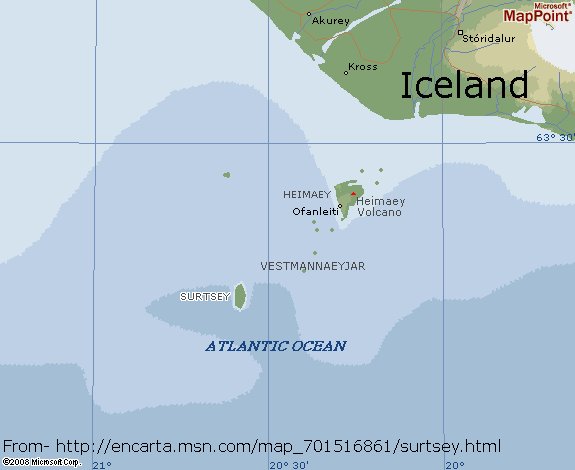Where Is Surtsey?

M o r e A b o u t S u r t s e y.
Surtsey is a island off the southern coast of Iceland formed by a volcanic eruption which began 130 metres (130 metres=426 ft) below sea level, and reached the surface on 14 November 1963. The eruption lasted until 5th of June 1967, when the island reached its maximum size of 2.7 km2 which is 1.0 sq mile. Since then the wind and waves have eroded and have caused the island to steadily diminish in size: as of 2002, the surface of Surtsey's area was 1.4 km2 or 0.54 sq mile.
The Surtsey eruption is among the longest eruptions to have occurred in the history of Iceland. The first signs of the impending eruption appeared on the morning of November 14, 1963, at a site roughly 18 km southwest of Heimaey, the largest of the Vestmannaeyjar (Westman Islands). The eruption is believed to have begun a few days earlier on the sea floor around 130 metres underwater.At the beggining explosive phases characterized the Surtsey eruption and due to the cooling effects of the sea's cold water, the hot magma(lava) transformed into tephra (volcanic ash). The tephra production was tremendous, and the island of Surtsey was begging and had already been formed the day after – on November 15.
The new island (Surtsey) was named after Surtr, a fire jotunn( an Icelandic giant from Norse mythology). It was intensively studied by volcanologists(those who study volcanos) during its eruption, and afterwards by botanists (those who study plants) and biologists (thoses who study biology) as life forms gradually colonised the originally barren island. The undersea vents that produced Surtsey are part of the Vestmannaeyjar (Westmann Isles) submarine volcanic system, part of the crack of the sea floor called the Mid-Atlantic Ridge.
The center of Surtsey is mad up of variably coarse tephra (volcanic asj) that was formed in prior volcanic eruptions. Above sea level the tephra (volcanic ash) had formed two crescent-shaped craters in the centre of the island. The base of the lava (magma) in Surtsey is, to quite a large extent, made of breccia (a sedimentary rock) , which was formed by rapid cooling and the sea eroding as the lava flowed from the volcano into the sea. Eruptions occurred in a total of eight locations on the island.